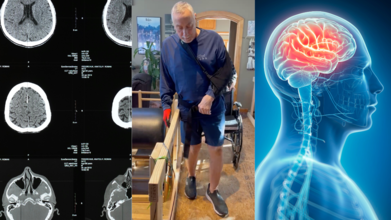- Health Conditions A-Z
- Health & Wellness
- Nutrition
- Fitness
- Health News
- Ayurveda
- Videos
- Medicine A-Z
- Parenting
- Web Stories
At 27, This Woman Couldn't Urinate On Her Own For 6 Years Until She Got Diagnosed With A Rare And Painful Condition

Credits: SWNS
Most of us, use the restroom is an effortless way, there is an urge to pee and so it is an easy, unconscious act. For 27-year-old Anna Gray from Bath, England, such a simple function was an impossible task—a task that defined her life for six long years! Diagnosed with Fowler's Syndrome, a rare and painful urinary disorder, Anna has spent more than a half-dozen years having to use catheters just to empty her bladder.
Anna's health emergency started in November 2018 when she was hospitalized with a severe kidney infection—brought on by not being able to urinate for several days. Physicians initially thought it was an isolated incident. But when her bladder had to be drained of almost two liters of urine and the issue continued, it was evident this was no typical infection.
Just weeks after that, another hospitalization uncovered something disturbing: Anna's bladder was not functioning at all. After invasive procedures, the reason still eluded her. Specialists eventually diagnosed her with Fowler's Syndrome—a condition so uncommon, even seasoned urologists had encountered only a handful of cases.
"I was informed there was nothing further that could be done," Anna remembered in an interview. "I couldn't comprehend how it could occur to me."
By 2020, after years of repeated infections and hospital stays, Anna was fitted with a suprapubic catheter—a tube inserted through her belly directly into her bladder. The catheter empties urine into a collection bag, which she has to empty several times a day.
"Coming to terms with this being my life now was really hard," she said. "There were mental health issues. I was in the hospital last year for depression."
In January 2024, Anna developed sepsis around her catheter site—a life-threatening complication that led to three weeks in intensive care. Yet despite the setbacks, she refuses to hide her condition.
“I wear shorts, tops—you can see the bag. It doesn’t bother me. People ask questions, and I’m fine with that.”
Because of the paucity of her condition, Anna first felt extremely isolated. "I felt like I was the only person in the world experiencing this," she said. But that ended when she learned about online support groups for Fowler's Syndrome patients.
"Meeting others who understood was life-altering. I finally didn't feel alone," said Anna.
Community support has become a lifeline for so many with chronic illnesses, especially those such as Anna whose conditions are under-recognized or misunderstood by the public and even the medical community.
Anna summed up, "I'm learning to live with it. I want people to know they're not alone. Even with a condition like this, life can still be full."
What is Fowler's Syndrome?
Initially identified in 1985, Fowler's Syndrome is an uncommon etiology of urinary retention in females, generally aged between 20 and 30 years. Fowler's Syndrome affects the urethral sphincter—the muscle that controls the release of urine—making the muscle remain constricted, even when the bladder is full. This leads to a lack of ability to urinate spontaneously.
In contrast to most other causes of urinary retention, Fowler's Syndrome is not associated with neurological disease. It may come on suddenly in some cases with no apparent cause. In others, it may follow surgery or delivery.
Symptoms of Fowler's Syndrome
Symptoms differ from patient to patient. Some may be able to urinate but not completely empty the bladder, while others—such as Anna—are completely retained. With the filling of the bladder, severe pain and frequent infection ensue. Many women experience recurring cystitis, kidney infections, and constant pain.
What Causes Fowler's Syndrome?
To this point, the true cause of Fowler's Syndrome has not been discovered. Scientists are still trying to determine why the urethral sphincter does not relax. Some speculations include hormonal connections, particularly because approximately 50% of patients also suffer from polycystic ovaries, yet no cause has been determined.
The syndrome could develop spontaneously or after surgery—most often gynecological or urological—or after delivery. Without an established cure, symptom management becomes the main priority.
Treatment for Fowler's Syndrome
Treatment of Fowler's Syndrome depends on severity.
Mild Cases: Patients with the ability to urinate partially might only require monitoring to assess residual bladder volume.
Moderate Cases: Those with high residual volumes might need intermittent self-catheterization several times a day to avoid infection and bladder damage.
Severe Cases: In complete retention cases, patients can be considered for sacral nerve stimulation—a treatment involving the use of electrical pulses to stimulate nerves and return bladder function. This is still the only treatment with hope of restoring natural urination in some patients.
Not Just Pills, Your Purpose In Life May Prevent Dementia, Study Finds

(Credit-Canva)
Dementia is no longer a far-off disease that affected a select few people, it is now a devastating reality most of us face, whether it due to our daily habits, when we wake up, what we eat and how much pollution we face. Anything and everything we do could change the trajectory of our brain health.
However, things are not as bleak, we still have the time to turn things around and take a healthier turn in life and it doesn’t have to be overcomplicated things. A simple change can make all the difference in the world.
A new research published in the American Journal of Geriatric Psychiatry looked into Blue Zones—areas where people live longer—has long suggested that having a sense of purpose is linked to a longer life. Now, a new study from UC Davis shows that having a purpose may also help protect the brain from cognitive decline.
The study followed over 13,000 adults aged 45 and older for up to 15 years. Researchers found that people who said they had a higher sense of purpose were 28% less likely to develop cognitive issues like mild cognitive impairment and dementia. This protective effect was seen across all racial and ethnic groups and was significant even when accounting for other factors like education, depression, and a gene that is known to increase the risk of Alzheimer's.
What Gives Your Life Purpose?
The researchers in this study didn't ask people to list what gave their life meaning. However, other studies on aging have shown that many different things can help you find a sense of purpose. The Japanese even have a word for it, "ikigai," which means "a reason for being."
Relationships: Spending quality time with loved ones, like caring for family or enjoying time with grandchildren.
Work or Volunteering: Continuing to work, mentoring others, or volunteering for a cause you care about.
Spirituality or Faith: Participating in spiritual practices or being an active member of a faith-based community.
Personal Goals: Taking up new hobbies, learning new skills, or working toward a personal goal, no matter how small.
Helping Others: Doing acts of kindness, taking on a caregiving role, or advocating for a cause.
Purpose Delays Cognitive Decline
The study also found that people with a strong sense of purpose started to experience memory and thinking problems later in life. On average, this delay was about 1.4 months over an eight-year period. While that might not sound like much, it's very significant.
Think about it this way, current medications for Alzheimer's can have a similar modest effect, but they often come with risks and are expensive. A sense of purpose, on the other hand, is a completely free, safe, and accessible way to improve your brain health. It's something anyone can work on, no matter their age or background.
Study Methods and Why It Matters
The people in this study were part of a large national survey. To measure a sense of purpose, researchers used a survey with questions like, "I have a sense of direction and purpose in my life."
Although this study showed a clear link between purpose and a healthier brain, it didn't prove that one directly causes the other which means the lack of purpose may not be the cause of dementia. However, the findings strongly suggest that being in a good mental and emotional state is a key part of healthy aging. Even if the socializing with the same people with The researchers are now hoping to find out if programs designed to help people find purpose could actually help prevent dementia in the future.
Ohio Man Walks Again After Stroke, Thanks To New Implant Technology

Credits: Canva and Thomas Fello
When Ohio restaurateur Tommy Fello left his restaurant on Christmas Eve, 2023, he thought his truck had a flat tire as it drifted off the road. Exhausted from preparing a holiday buffet since early morning, the then 71-year-old slowly drove home, leaning on his vehicle’s autocorrect system.
But the real problem wasn’t the truck, it was him.
As soon as Fello stepped out of his vehicle, he couldn’t steady himself. Minutes later, he collapsed, unable to move his left arm and leg. Doctors confirmed he had suffered a stroke.
Life After Stroke: Small Victories, Big Struggles
A clot-busting drug saved Fello’s life, but the damage lingered. He lost sensation on the left side of his body, struggled to swallow, and endured intense pain from his curled, immobile arm.
Physical and occupational therapy brought minor improvements, but progress was painfully slow. “Even lifting a cup felt like a gigantic accomplishment,” Fello recalled. “But I kept asking myself—is this as good as it’s going to get?”
The Promise of New Technology
In early 2024, Fello learned of a pioneering device called the Vivistim System, an FDA-approved implant developed by MicroTransponder Inc. The device pairs vagus nerve stimulation (VNS) with rehabilitation exercises to boost recovery in stroke patients with long-standing deficits.
Here’s how it works: during therapy sessions, wireless signals activate the implant, sending gentle pulses to the vagus nerve. These pulses enhance the brain’s ability to “rewire” itself, a process known as neuroplasticity. Patients also continue daily exercises at home.
According to neurosurgeon Dr. Erez Nossek of NYU Langone, who spoke to CBS News, the stimulation allows stroke survivors to achieve “greater and faster improvements in motor function.” A major trial published in The Lancet in 2021 showed patients using Vivistim had two to three times more improvement in arm and hand function compared with standard rehab.
First Patient at Cleveland Clinic
By April 2025, after consulting with Dr. Mark Bain, a cerebrovascular neurosurgeon at Cleveland Clinic, Fello became the hospital’s first patient to receive the implant.
The one-hour surgery placed the key-fob sized device under his clavicle, with tiny leads connected to the vagus nerve in his neck. Bain noted the procedure carries less than a 1% risk of complications. Two weeks later, the device was activated, and Fello resumed therapy with occupational therapist Dr. Sharon Covey.
Remarkable Progress
Within four months, Fello reported dramatic improvement. The constant pain and stiffness in his arm vanished, and he began practicing daily tasks, like carrying objects with his left hand, that were once impossible.
Covey described his progress as “huge,” noting that even the ability to use his left arm for basic tasks is “something he could not have done before.”
Fello, now 72, couldn’t be more optimistic. “I’m very happy I did it. I’m proud, and I can see the progress every day.”
A New Era in Stroke Recovery
Each year, about 800,000 Americans suffer an ischemic stroke, according to experts. While traditional rehabilitation remains essential, many patients plateau, leaving them with lifelong disabilities.
Vivistim represents a new frontier. “This is the first real breakthrough in stroke rehab in decades,” said Covey. “It’s going to turn the stroke recovery world upside down.”
Dr. Bain agrees: “In the next five to ten years, we’ll see an explosion of new technologies that help stroke patients reclaim their lives. With innovations like this—the sky’s the limit.”
For Fello, that future has already begun.
Your Eyes May Reveal Memory Trouble Before Doctors Notice It

Credits: iStock
Our eyes not just windows to the soul perhaps they are mirrors of our cognitive health as well. Recent research suggests that subtle changes in how we scan our visual environment might be a sign of memory loss, providing a painless window into mental health far beyond the classic testing methods.
As we get older, the patterns through which our eyes move—how they scan, lock, and dart between visual fields—evolve slowly. These changes are not only driven by age but also by neurological disease. Researchers from Canada and the West Indies have now found evidence that these patterns of eye movement are closely associated with memory performance, suggesting that our sight could indicate the beginnings of cognitive decay.
The researchers conducted eye-tracking experiments on groups of young and older adults, including participants diagnosed with memory-affecting conditions. By analyzing how their eyes explored images, both on first viewing and upon repetition, the team was able to identify distinct differences in visual behavior.
The results were dramatic. The subjects with compromised memory performance tracked highly consistent gaze patterns from one image to the next, scanning the same areas over and over instead of examining the full field of view. This decreased variability and diminished exploration—lower dispersion of eye movements was contrasted with the more flexible and individualized scanning observed in subjects with better memory.
"Reduced eye movement diversity seems to mirror the cognitive limitations beneath," the scientists write in their research published in PNAS. "Without even having to perform tasks consciously, patterns of gaze differed systematically by group, making them a potential early indicator of memory decline."
How Do Your Eyes Reflect Your Brain Activity?
While the research did not explore in depth the mechanisms underlying these results, previous studies have indicated a close relationship between eye movement and the hippocampus, the area of the brain that is involved in creating and retrieving memory. Alterations in this important region may not only have a deleterious effect on recall but also modify visual attention directed by the brain.
Previous research has shown that eye properties—such as saccadic movement and pupil dilation—have been correlated with cognitive health and even used to predict the development of diseases like Alzheimer's disease. What this study does differently is that it looks at naturalistic gaze behavior, which records people looking at real-world complex stimuli in their natural settings, compared to simple laboratory tasks.
Can Your Eye Movement Be Used As A New Tool for Early Detection?
These findings have important implications. If confirmed in larger, longitudinal studies, eye-tracking measures could offer a quick, cheap, and non-invasive tool to identify early cognitive decline. In contrast to MRI scans or time-consuming neuropsychological testing, this method may be feasible during routine clinical visits or even with digital tools at home.
Scientists propose that eye-tracking might be added to other preclinical diagnostic measures, allowing clinicians to spot vulnerable individuals before difficulties with memory become evident in everyday life. Early diagnosis is important because treatments—pharmacological, lifestyle-oriented, or cognitive—work best when initiated prior to extensive neural damage.
Continuum of Brain Health
One of the main findings of the research is that eye movement change runs on a continuum and indicates gradual decline in brain function and not sudden onset of disease. Even among non-demented, non-cognitively impaired individuals, subtle diminution in exploratory patterns of gaze can presage early or preclinical brain changes.
"This work shows the promise of naturalistic gaze patterns as a sensitive marker for cognitive decline," the researchers write. "Monitoring these patterns longitudinally would make it possible to assess memory health throughout life."
While exciting, the actual clinical utility of this research is still in the distance. Additional studies are necessary to standardize eye-tracking protocols, to estimate the predictive accuracy of gaze metrics, and to define thresholds distinguishing normal aging from incipient cognitive impairment.
Advances in wearable eye-tracking devices, smartphone cameras, and artificial intelligence-powered analysis may speed the translation of these results into daily health monitoring. Think about how cool it would be to have a future where small changes in how you look at a screen or at your environment could warn you or your physician of the first signs of memory loss—months or even years before forgetfulness invades daily life.
Our eyes do more than lead us through the physical world they reflect the state of our mind. As this study shows, the patterns of our gaze hold secret signs of cognitive health and memory function. By tapping these insights, researchers are opening a new frontier for early detection and monitoring of memory loss, holding out hope for proactive treatments and improved brain health outcomes around the world.
© 2024 Bennett, Coleman & Company Limited

